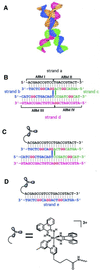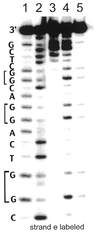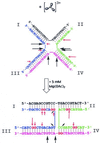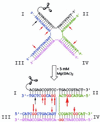Charge transport through DNA four-way junctions
- PMID: 11353071
- PMCID: PMC55456
- DOI: 10.1093/nar/29.10.2026
Charge transport through DNA four-way junctions
Abstract
Long range oxidative damage as a result of charge transport is shown to occur through single crossover junctions assembled from four semi-complementary strands of DNA. When a rhodium complex is tethered to one of the arms of the four-way junction assembly, thereby restricting its intercalation into the pi-stack, photo-induced oxidative damage occurs to varying degrees at all guanine doublets in the assembly, though direct strand scission only occurs at the predicted site of intercalation. In studies where the Mg(2+) concentration was varied, so as to perturb base stacking at the junction, charge transport was found to be enhanced but not to be strongly localized to the arms that preferentially stack on each other. These data suggest that the conformations of four-way junctions can be relatively mobile. Certainly, in four-way junctions charge transport is less discriminate than in the more rigidly stacked DNA double crossover assemblies.
Figures






Similar articles
-
Oxidative charge transport through DNA in nucleosome core particles.Chem Biol. 2002 Apr;9(4):403-15. doi: 10.1016/s1074-5521(02)00121-7. Chem Biol. 2002. PMID: 11983330
-
Oxidative thymine dimer repair in the DNA helix.Science. 1997 Mar 7;275(5305):1465-8. doi: 10.1126/science.275.5305.1465. Science. 1997. PMID: 9045609
-
Long-range guanine oxidation in DNA restriction fragments by a triplex-directed naphthalene diimide intercalator.Biochemistry. 2000 May 23;39(20):6190-9. doi: 10.1021/bi000285s. Biochemistry. 2000. PMID: 10821694
-
DNA photofootprinting with Rh(phi)2bpy3+.Methods Mol Biol. 1994;31:331-7. doi: 10.1385/0-89603-258-2:331. Methods Mol Biol. 1994. PMID: 7921029 Review. No abstract available.
-
Detection of DNA base mismatches using DNA intercalators.Methods Enzymol. 2002;353:506-22. doi: 10.1016/s0076-6879(02)53073-1. Methods Enzymol. 2002. PMID: 12078523 Review. No abstract available.
Cited by
-
Charge transfer through DNA nanoscaled assembly programmable with DNA building blocks.Proc Natl Acad Sci U S A. 2006 Nov 28;103(48):18072-6. doi: 10.1073/pnas.0607148103. Epub 2006 Nov 20. Proc Natl Acad Sci U S A. 2006. PMID: 17116889 Free PMC article.
-
Long-distance radical cation reactions in DNA three-way junctions: inter-arm interaction and migration through the junction.Nucleic Acids Res. 2003 Oct 1;31(19):5692-9. doi: 10.1093/nar/gkg756. Nucleic Acids Res. 2003. PMID: 14500833 Free PMC article.
-
C5'- and C3'-sugar radicals produced via photo-excitation of one-electron oxidized adenine in 2'-deoxyadenosine and its derivatives.Nucleic Acids Res. 2006 Mar 14;34(5):1501-11. doi: 10.1093/nar/gkl026. Print 2006. Nucleic Acids Res. 2006. PMID: 16537838 Free PMC article.
References
-
- Núñez M.E. and Barton,J.K. (2000) Probing DNA charge transport with metallointercalators. Curr. Opin. Chem. Biol., 4, 199–206. - PubMed
-
- Kelley S.O. and Barton,J.K. (1998) Radical migration through the DNA helix: chemistry at a distance. Metal Ions Biol. Syst., 26, 211–249. - PubMed
-
- Ames B. (1983) Dietary carcinogens and anticarcinogens—oxygen radicals and degenerative diseases. Science, 221, 1256–1264. - PubMed
-
- Piette J. (1991) Mechanism of DNA cleavage mediated by photoexcited nonsteroidal antiinflammatory drugs. J. Photochem. Photobiol. B, 11, 241–260. - PubMed
-
- Simon M.I. and Van Vunakis,H. (1962) The photodynamic reaction of methylene blue with DNA. J. Mol. Biol., 4, 488–499. - PubMed
Publication types
MeSH terms
Substances
Grants and funding
LinkOut - more resources
Full Text Sources
Other Literature Sources
Research Materials
Miscellaneous

